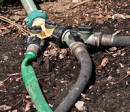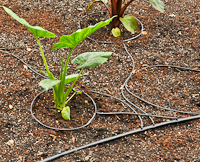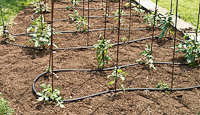|

Many
systems are now available to provide a slow, constant flow of
water to plants. Trickle or drip systems have many advantages
including:
-
Economy of Water
Use: Trickle systems use ½ to 1/3 as much water
as sprinkler irrigation.
-
Ease of
Operation: Once the
system is installed, it is merely a matter of opening
valves.
-
Fewer Foliage
Diseases: The
foliage remains dry since the water is delivered to the root
zone of the plant only. Fungal diseases prosper when foliage
is kept wet.
-
Less Fertilizer:
There is less runoff and
fertilizers
may be applied to the
immediate area adjacent to the row. They may also be applied
directly through the irrigation system.
-
Less Insecticide
and Fungicide Use:
Pesticides are not washed from
the foliage as they are with overhead systems.
-
Minimal
Contamination of Ground Water:
With limited water volumes being applied, there
is less leaching of fertilizers into ground waters.
There are also a few disadvantages to drip
or trickle irrigation including:
-
Cost:
The initial cost of the equipment is generally more
expensive than sprinkler systems.
-
Maintenance:
The small holes in the emitters may become clogged over
time. Some systems must be drained and "blown out" with an
air compressor each fall to prevent freezing. Insects and
rodents may damage trickle line emitters.
Overall, the pros outweigh the cons for most
trickle or drip irrigation systems. Consider them for use in
the home landscape or garden to produce healthier, stress free
plants.
|



